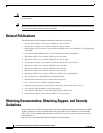
1-2
Cisco IOS Software Configuration Guide for Cisco Aironet Access Points
OL-29225-01
Chapter 1 Overview
Features
• The 1300 series outdoor access point/bridge uses an integrated antenna and can be configured to use
external, dual-diversity antennas.
• The 2600 series access point contains dual-band radios (2.4 GHz and 5 GHz) with integrated and
external antenna options. The access points support full inter-operability with leading 802.11n
clients, and support a mixed deployment with other access points and controllers.
• The 3600 series access point contains a third radio slot. The autonomous mode is not supported on
the third radio.
This chapter contains the following sections:
• Features, page 1-2
• Management Options, page 1-3
• Roaming Client Devices, page 1-3
• Network Configuration Examples, page 1-3
Features
This section lists features supported on access points running Cisco IOS software.
Note The proxy Mobile-IP feature is not supported in Cisco IOS Releases 12.3(2)JA and later.
Features Introduced in This Release
This section describes the new features in Cisco IOS Release 15.2(4)JA and contains these topics:
• Support for IPv6, page 1-2
• Support for Guest Access, page 1-2
• Support for 802.11w, page 1-3
Support for IPv6
Cisco IOS Release 15.2(4)JA supports IPv6 protocols. IPv6 is the latest Internet protocol for IPv4. It
uses 128-bit addresses as opposed to the 32-bit addresses that are used in IPv4. Cisco IOS Release
15.2(4)JA supports these unicast addresses:
• Aggregatable Global Address: These addresses are globally routable and reachable on the IPv6
portion of the Internet. Global addresses are identified by the format prefix of 001.
• Link-local address: These addresses are automatically configured on interface using:
–
Link-local prefix FE80::/10 (1111 1110 10)
–
Interface identifier in the modified EUI-64 format.
Support for Guest Access
Cisco IOS Release 15.2(4)JA supports guest access to the network. Guest networks provide access to the
Internet and intranet without compromising the security of the host enterprise network.


















